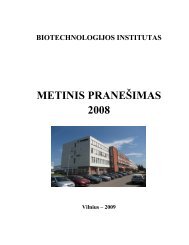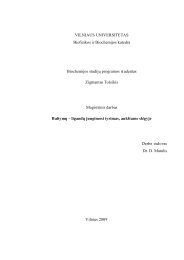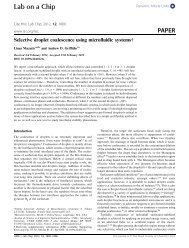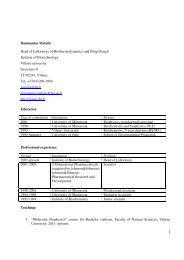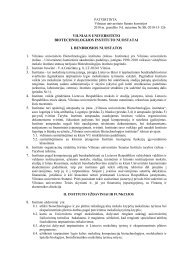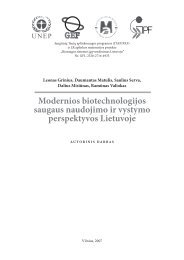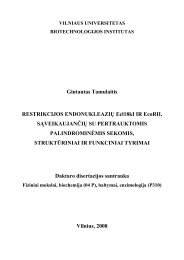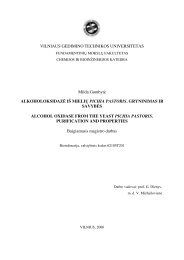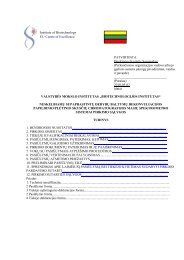Report 2008-2010
Report 2008-2010
Report 2008-2010
You also want an ePaper? Increase the reach of your titles
YUMPU automatically turns print PDFs into web optimized ePapers that Google loves.
In conclusion, the dual potential of MUC1-harboring VLPs in inducing<br />
both a humoral and cytotoxic immune response make them an attractive<br />
adjunct to traditional cytotoxic agents for tumor eradication.<br />
HaPyV VP1-derived VLPs may represent promising vaccines not only<br />
for viral infections but also for cancer and auto-immune diseases as<br />
are successfully employed for hybridoma technology.<br />
Development of diagnostic tools for Merkel cell polyoma virus<br />
The project was supported by the Lithuanian State Science and Studies<br />
Foundation grant N-09005 in 2009 and by Research Council of<br />
Lithuania in <strong>2010</strong>.<br />
Merkel cell carcinoma (MCC) is rare but very aggressive skin cancer.<br />
The number of cases of this disease is increasing and the prognosis for<br />
MCC patients depends greatly on the stage of the disease at the time<br />
of diagnosis. Merkel cell polyoma virus (MCPyV) was found in <strong>2008</strong><br />
and it was identified as etiologic agent of human Merkel cell carcinoma.<br />
MCC diagnostics in Lithuania is based on clinical symptoms<br />
and MCPyV was never investigated as MCC etiologic agent. The project<br />
aims to generate the recombinant MCPyV capsid protein and develop<br />
modern assays for molecular diagnostics and<br />
immunodiagnostics of MCPyV infections in Merkel carcinomas.<br />
The synthetic MCPyV VP1 gene was cloned in yeast expression system<br />
and MCPyV VP1 virus like particles (VLPs) were purified. It was shown<br />
that after immunization of mice MCPyV VP1 VLPs activated B and T<br />
cells and induced humoral and cellular immune response. 9G6, 24D11<br />
11A2 monoclonal antibodies recognizing MCPyV VP1 VLPs were generated<br />
and 11A2 were successfully used for MCPyV diagnostics in immunohistochemical<br />
assay using 2 clinical MCC samples. PCR-based<br />
assay was positive for 5 clinical MCC samples using 4 pairs of primers<br />
and sequencing of obtained DNA fragments confirmed presence of<br />
MCPyV in these samples. The KI polyoma virus VP1 protein encoding<br />
gene was cloned and expressed in yeast also. For investigation of the<br />
prevalence of MCPyV and other human polyoma viruses in Lithuania<br />
the MCPyV, KIPyV, JCV, BKPyV, SV40 VP1 VLPs were used for serological<br />
assays.<br />
Engagement of metagenomic analysis of extremophile viruses<br />
from hot underground waters of Lithuania searching for the new<br />
enzymes<br />
The project was supported 2007-2009 by the Lithuanian State Science<br />
and Studies Foundation grant N-07005<br />
Microorganisms that survive in the extreme environments are of great<br />
interest, because they can serve as a source of enzymes having unique<br />
properties. Identification and cultivation of unknown viruses directly<br />
from the environment is complicated but metagenomic analyses of<br />
uncultured viral communities can provide insights into the composition<br />
and structure of environmental viral communities and are wellspring<br />
of novel sequences and new genes.<br />
The aim of this study was to search for the new enzymes of viruses<br />
from the extreme environment. We examined the variety of bacterial<br />
viruses present in natural hot underground waters of Lithuania and<br />
artificial overground chilled water of thermal power-station enginery,<br />
waste water treatment reservoirs (thermal power-station of Elektrenai)<br />
and urban effluent water of Vilnius were examined. The results of<br />
the electron microscopy revealed that tailed phages belonging to the<br />
order Caudovirales were predominant in all samples tested. Based on<br />
the shape and morphology these phages could be assigned to the<br />
virus families Siphoviridae, Myoviridae and Podoviridae. Viral particles<br />
with apparent morphology of the Lipotrixviridae, Tectiviridae and Inoviridae<br />
families were also observed. Although the DNA extracted<br />
from the viral fraction from all sources and amplified using phi29 DNA<br />
polymerase was mostly soil and water ecosystems bacteria-derived<br />
some of the samples of DNA shared sequence similarities with fragments<br />
of genes of phages as Thermus phage phiYS40 which was extracted<br />
and enriched from DNA samples collected from the chilled<br />
water of thermal power-station enginery samples.<br />
Viral particles with apparent morphology of the Myoviridae, Siphoviridae,<br />
Inoviridae and Tectiviridae families were detected by electron microscopy<br />
of the thermophiles-enriched samples. The viral fraction of<br />
DNA isolated from the enriched samples appeared to encode ORF`s<br />
(or their segments), that shared sequence relatedness with Geobacillus,<br />
Clostridium, Heliobacterium, Listeria, Bacillus and Staphylococcus<br />
phage or prophage proteins. A fair amount of the ORF`s mentioned<br />
showed a certain degree of amino acid sequence identity with various<br />
proteins of Clostridium botulinum phage c-st or Bacillus subtilis<br />
phage SPBc2. Among the DNA extracted from the samples that were<br />
enriched at 60-65ºC and 55ºC, the reverse transcriptase, lisozyme and<br />
adenine- or cytosine-specific DNA methylase and DNA polymerase<br />
genes (or gene fragments) were detected. A bioinformatics analysis of<br />
several predicted ORF`s with unknown function identified two more<br />
possible candidates potentially useful in biotechnology: the viral sitespecific<br />
endonuclease and DNA polymerase.<br />
Two lytic Geobacillus staerothermophilus phages 2-11-1 and 2-11-2<br />
with the double-stranded DNA genomes of ~40 and 55 kbp, respectively,<br />
as well as temperate Geobacillus bacteriophage 2KT-1 were isolated.<br />
The complete sequences for the lysozyme gene of these phages<br />
2-11-2 and 2KT-1 were determined, and the gene for the lysozyme of<br />
2KT-1 was cloned and overexpressed in E. coli. Bacteriophages belonging<br />
to the T4-type and smaller E. coli myoviruses that prefer higher<br />
temperature for growth (~48ºC) were also isolated. The complete or<br />
partial sequences for DNA polymerase as well as DNA and RNA ligase<br />
genes of these phages were determined. The gene for the DNA ligase<br />
of bacteriophage FV3, showing 56% of amino acid sequence identity<br />
with the DNA ligase orthologue of phage RV5, was cloned and overexpressed<br />
in E. coli.<br />
Expression of glycoproteins of mumps and measles viruses in<br />
yeast<br />
Proteomic approach was applied to study molecular processes leading<br />
to formation of insoluble and inactive aggregates of recombinant<br />
mumps virus hemagglutinin-neuraminidase (MuHN) and measles<br />
virus hemagglutinin (MeH) in yeast Saccharomyces cerevisiae cells<br />
Overexpression of cytoplasmic cell stress proteins Ssa1/2, Ssa4, Sse1,<br />
Hsc82, Hsp104, Sti1 and Sgt2 in response to MuHN and MeH synthesis<br />
indicated the presence of a stress response specific to accumulation<br />
of secretory protein precursors in the cytoplasm. Major cellular components<br />
of insoluble MuHN and MeH aggregates, directly interacting<br />
with recombinant viral proteins, appeared to be cytoplasmic heat<br />
shock proteins Ssa1/2p and Hsp26, the endoplasmic reticulum (ER)<br />
chaperone BiP/Kar2p was also identified. We may conclude the reason<br />
of inefficient virus surface glycoprotein expression in yeast lies on different<br />
protein maturation processes in mammalian and yeast cells,<br />
comprising translocation across the ER membrane and/or protein<br />
folding in the ER lumen. Now our lab is involved into the improvement<br />
of yeast expression systems for generation of active human virus<br />
surface glycoproteins.<br />
35 th anniversary<br />
30



